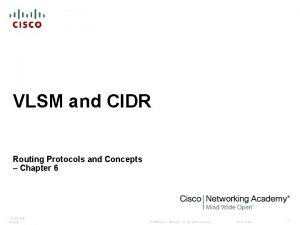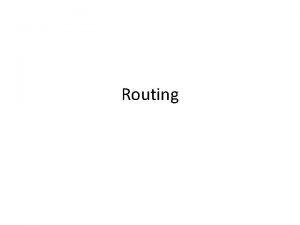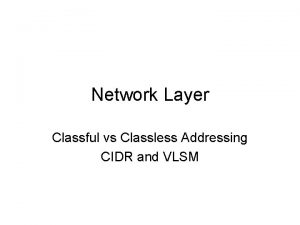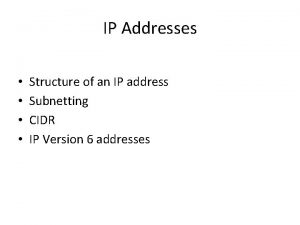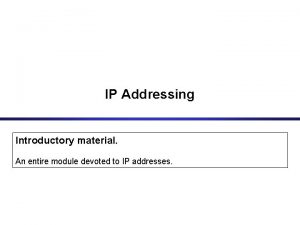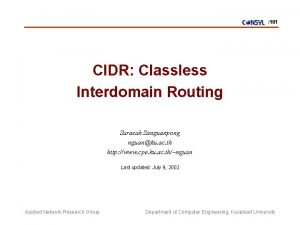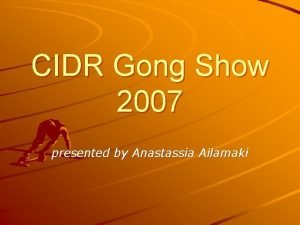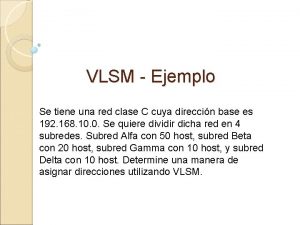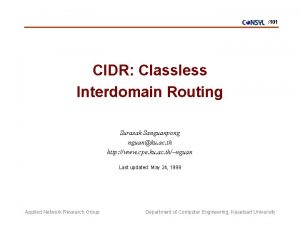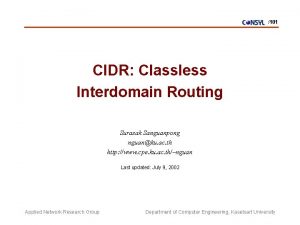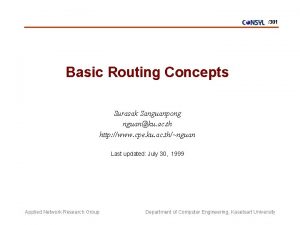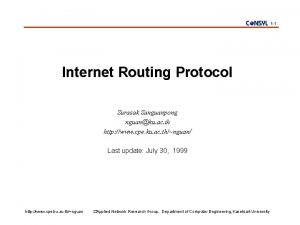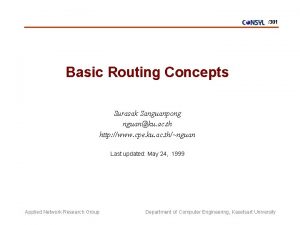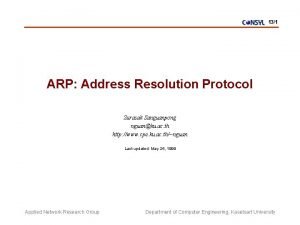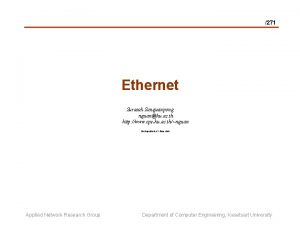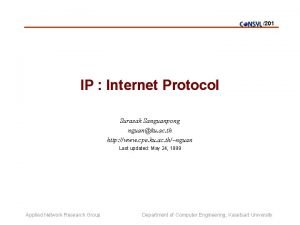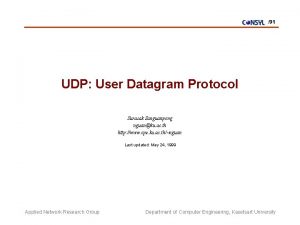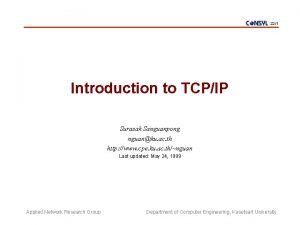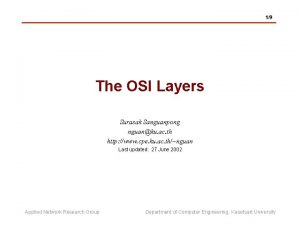101 CIDR Classless Interdomain Routing Surasak Sanguanpong nguanku












- Slides: 12

/101 CIDR: Classless Interdomain Routing Surasak Sanguanpong nguan@ku. ac. th http: //www. cpe. ku. ac. th/~nguan Last updated: July 9, 2002 Applied Network Research Group Department of Computer Engineering, Kasetsart University

/102 Address allocation problem l Exhaustion of the class B network address space. l The lack of a network class of a size which is appropriate for mid-sizes organization ; l l l (1 (2 (3 (4 (5 (6 (7 class C, with a max of 254 hosts, is too small , while class B, with a max of 65534 hosts, is too large. Allocate blocks of class C instead and downside is more routes entry in routing table requires fewer than 256 addresses 1 class C network requires fewer than 512 addresses 2 contiguous class C networks requires fewer than 1024 addresses 4 contiguous class C networks requires fewer than 2048 addresses 8 contiguous class C networks requires fewer than 4096 addresses 16 contiguous class C networks requires fewer than 8192 addresses 32 contiguous class C networks requires fewer than 16384 addresses 64 contiguous class C networks Applied Network Research Group Department of Computer Engineering, Kasetsart University

/103 Routing Table problems l Issue multiple (block) class C addresses (instead single class B address) solves a running out of class B address but. . . l Introduces a problem of routing table l l l By default, a routing table contains an entry for every network How large a routing table should be for all Class C networks? Growth of routing table in the Internet routers beyond the ability of current software and hardware to manage Applied Network Research Group Department of Computer Engineering, Kasetsart University

/104 Route Non-Aggregation ����� Internet ������� �� , 202. 0. 32. 0/24 , 202. 0. 1. 0/24 ISP 1 , 202. 0. 1. 0/24 , 202. 0/24 202. 0. 3. 0/24 ISP 2 - 202. 0. 0. 0 202. 0. 15. 0 202. 0. 1. 0 , 202. 0. 33. 0/24 , 202. 0/24 202. 0. 3. 0/24 - 202. 0. 0. 0 202. 0. 255. 0 , 202. 0. 32. 0/24 202. 0. 33. 0/24 - 202. 0. 32. 0 202. 0. 47. 0 202. 0. 32. 0 ISP 3 202. 0. 33. 0 202. 0 Applied Network Research Group Department of Computer Engineering, Kasetsart University

/105 BGP routing Table Applied Network Research Group Department of Computer Engineering, Kasetsart University

/106 How to Solve l l Topological allocate IP address assignment We divide the world into 8 regions like this : (RFC 1466( Multi-regional Europe Others North America Central/South America Pacific Rim Others 193. 255 - 192. 0. 0. 0 195. 255 - 194. 0. 0. 0 197. 255 - 196. 0. 0. 0 199. 255 - 198. 0. 0. 0 201. 255 - 200. 0 203. 255 - 202. 0. 0. 0 205. 255 - 204. 0. 0. 0 207. 255 - 206. 0. 0. 0 IANA reserved 223. 255 - 208. 0. 0. 0 Applied Network Research Group Department of Computer Engineering, Kasetsart University

/107 Route Aggregation Internet 202. 0. 0. 0/16 ������������ ISP 1 202. 0. 0. 0/16 202. 0. 32. 0/20 202. 0. 0. 0/20 ISP 2 202. 0. 0. 0/20 202. 0. 32. 0/20 ISP 3 202. 0. 1. 0 202. 0. 32. 0 202. 0. 33. 0 202. 0 Applied Network Research Group Department of Computer Engineering, Kasetsart University

/108 Classless Interdomain Routing l Class C address’s concept becomes meaningless on these route between ‘domains’, the technique is called Classless Interdomain Routing or CIDR (pronounce cider ( l Key concept is to allocate multiple IP addresses in the way that allow summarization into a smaller number of routing table (route aggregate( l CIDR is supported by BGP 4 and based on route aggregation l e. g 16 class C addresses can be summarized to a single routing entry (router can hold a single route entry for the main trunks between these areas Applied Network Research Group Department of Computer Engineering, Kasetsart University

/109 Supernetting l CIDR is also called Supernetting in contrast to subnetting l an organization has been allocated a block of class C addresses in 2 n with contiguous address space l l archive by using bits which belongs to the network address as host bits class C example : altering the default class C subnet mask such that some bit change from 1 to 0 )Super) netmask 4 class C networks appear to networks outside as a single network 0000 0011111111 255. 252. 0 Applied Network Research Group Department of Computer Engineering, Kasetsart University

/1010 Supernetting Sample l an organization with 4 class C l 190. 0. 35. 0 190. 0. 34. 0 , 190. 0. 33. 0 , 190. 0. 32. 0 0000 0011111111 mask = 255. 252. 0 00001000 0000 11000010 net = 190. 0. 32. 0 0000 01001000 0000 11000010 net = 190. 0. 33. 0 0000 1000 0000 11000010 net = 190. 0. 34. 0 0000 11001000 0000 11000010 net = 190. 0. 35. 0 Bit wise AND results 190. 0. 32. 0 l This organization’s network has changed from 4 net to a single net with 1022 hosts Applied Network Research Group Department of Computer Engineering, Kasetsart University

/1011 The Longest Match Supernetting l Europe has 194. 0. 0. 0 - 195. 255 with mask 254. 0. 0. 0 l A case of one organization (195. 0. 16. 0 -195. 0. 36. 0 mask 255. 254. 0) needs different routing entry l datagrams 195. 0. 20. 1 matches both Europe’s and this organization. How to do? l Routing mechanism selects the longest mask (255. 254. 0 is longer than 254. 0. 0. 0), then route to the organization Applied Network Research Group Department of Computer Engineering, Kasetsart University

/1012 Summary l l l routing decisions are now made based on masking operations of the entire 32 bit address, hence the term “classes” No existing routes is changed CIDR slows down the growth of routing tables (current ~ 50 K entries in core routers( Short term solution to solve routing problem limitation : not all host/router software allows supernet mask Applied Network Research Group Department of Computer Engineering, Kasetsart University




